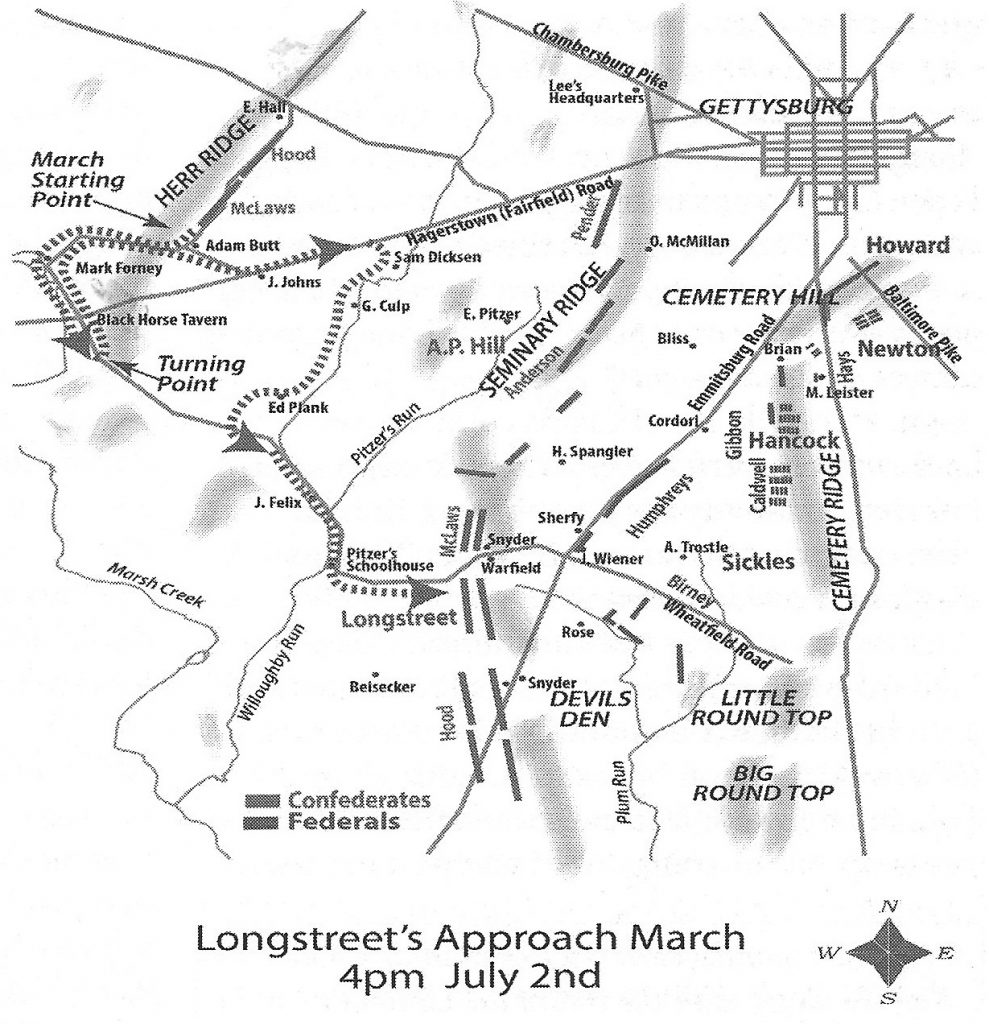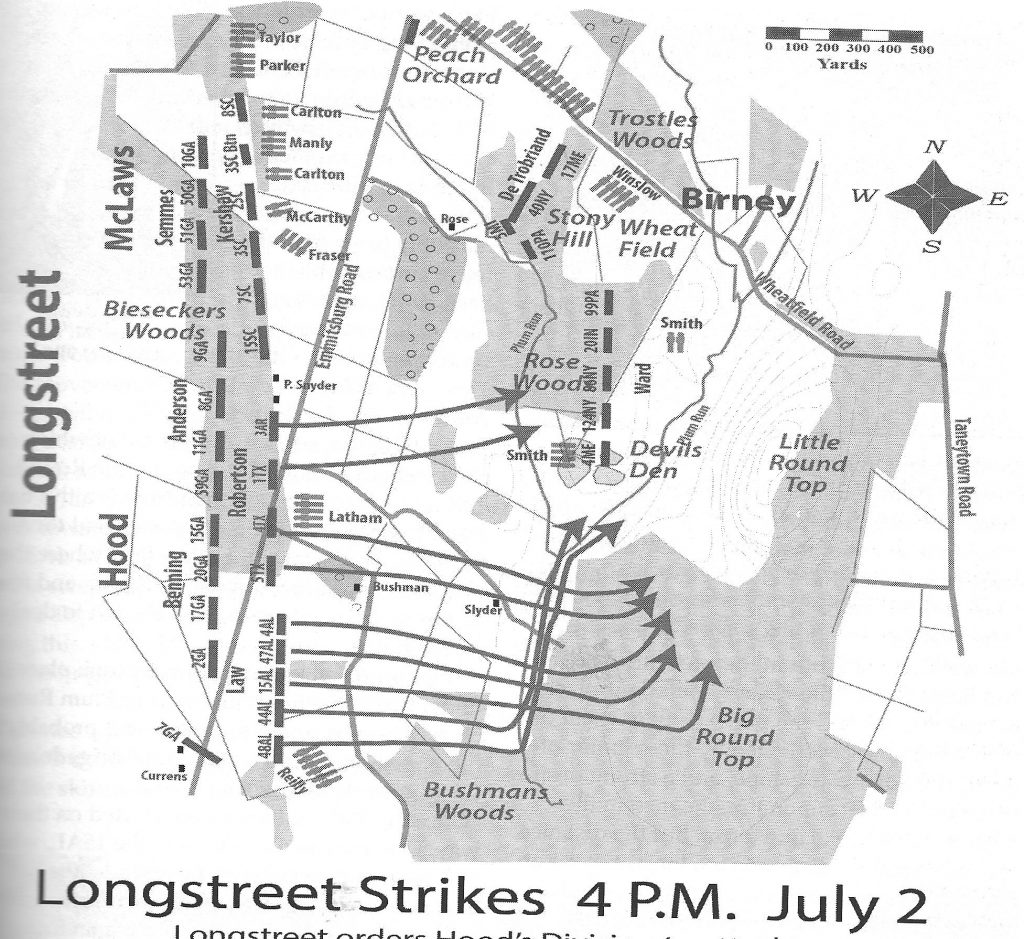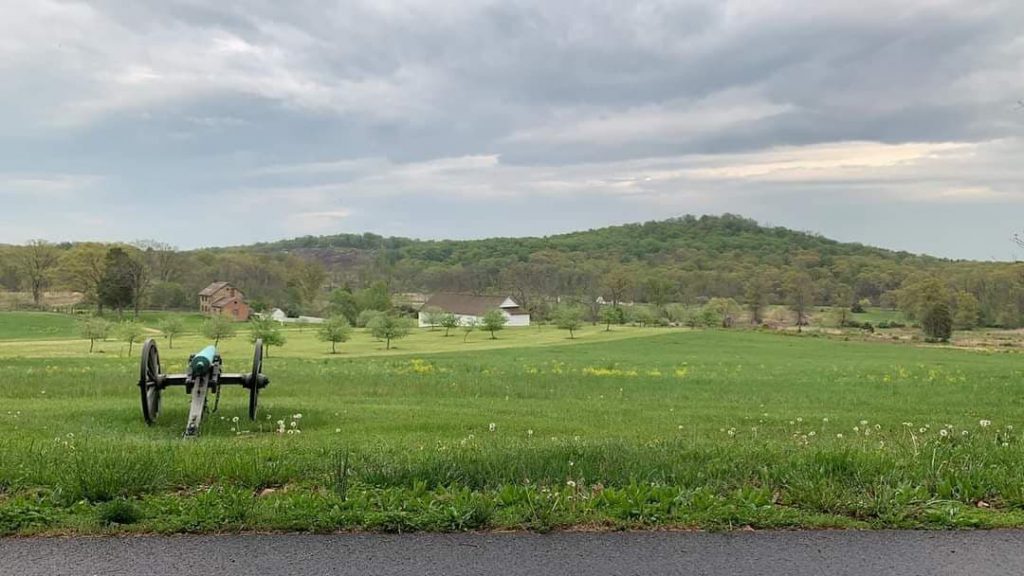History does not precisely record whether or not CPT Johnston completed his recon of the Union Left flank and returned to make his report to Lee, before or after LTG Longstreet left Lee’s HQ. It seems quite likely that Longstreet was not privy to Johnston’s report. But when Lee heard it, it contained nothing that would have altered his orders to Longstreet concerning the planned flank attack.
For his part, Longstreet rode back towards Cashtown where MG Hood’s Division was encamped along with the vanguard of MG McLaws’ Division. The final brigade of that division had yet to close with the rest. They did not arrive until about noon. Longstreet dispatched his Reserve Artillery Battalion led by COL Edward Alexander to establish a position near the south end of Seminary Ridge to support the planned attack.
Finally, in the early afternoon, McLaws’ final elements were in place and Longstreet began the march south. Alexander sent back word that there was a Union observation post on or near Big Round Top and that Longstreet would lose the element of surprise if they spotted his approach. If Longstreet continued on the most direct route, he was surely to be seen by the signalmen. He was forced to shift his line of march closer to the ridge to mask his approach. Since he had McLaws’ Division in the lead, and he wanted to keep it that way, he could not simply turn his two divisions about face. Instead he took the added time to move McLaws’ Division past Hood’s to stay as the lead element. All of this took valuable time. Lee seemed blissfully unaware of these delays. He had envisioned a mid-morning attack and had alerted Ewell to that timing. So Ewell’s men too were in a state of anticipation – for hours on end.

[At this point in the battle scenario a number of things began to happen simultaneously, but we will need to relate them in a more linear fashion.]
It was nearing 4PM, when McLaws’ Division finally rounded the south end of Seminary Ridge. The intention was that he’d move his men onto the Emmittsburg Road and there shift into attack formation. As soon as Hood’s division had done likewise, the two would march north in a movement to contact, probing to locate the Union left flank. Alexander had established his artillery positions in the dense woods to the south of Seminary Ridge beyond the point of McLaws U-turn around the ridge. Therefore, Alexander could not warn McLaws or Longstreet of what lay ahead.
No sooner than they came out from behind the ridge when Sickles’ artillery opened fire completely surprising McLaws’ lead elements. They dropped to the ground in a hail of fire. MG McLaws and LTG Longstreet were riding together at the back of the division still behind the ridge line. An artillery barrage was the last thing that they expected. Even before it started, Lee’s plan for a surprise attack on the Union flank was falling apart. With McLaws’ men pinned down by cannon fire, Longstreet quickly ordered Hood to move his division past McLaws and to swing it south then east into attack formation.
As he reached his point of departure, Hood’s men can under fire from Birney’s right flank near the wheat field. It was Hood’s men that Warren had likely sighted off to the south. Hood quickly aligned his three brigades to attack Birney from the south.
Meade had responded immediately to Warren’s messenger [see Section 6e] and made his way south to find Sickles. Meade found his HQ in the Trostle farmhouse a few hundred yards west of the Saddle. Meade was livid that Sickles had shifted his entire corps forward. He was on the verge of ordering him to return to LRT when their conversation was interrupted by the sound of cannon fire. It was immediately obvious that retreat was out of the question. Lee had launched his Day 2 attack. It was 4PM!
While McLaws’ unit commanders struggled to move his five brigades into something resembling an attack formation, Hood had aligned his four in the woods. They moved forward almost due east and then in an echelon shift from left to right they turned slightly northward to engage Birney’s men; first at Rose Wood then into Devil’s Den. BG Law’s brigade was on the far right flank. They continued to move eastward up to Big Round Top and then north. In the center of his formation was the 15th Alabama Regiment. With musket balls swirling around them, they found themselves in a stream bed so that they were walking under the fuselage of fire.
But before the nearly suicidal charge by the 20th Maine [Section 6e], fighting was taking place at dozens of points between LTR and the Peach Orchard. A Wheat Field guarded by Birney’s Division is said to be one of the bloodiest pieces of real estate in the world. As Hood’s men formed up and charged forward that field changed hands multiple times. By late afternoon, McLaws had dislodged Humphrey’s Division from the orchard and despite reinforcements being brought in from all parts of the Union line, the Third Corps salient finally crumbled and the entire corps plus thousands of other men fell back to LRT. Most of them passed through the Saddle in that retreat.
In many ways, Day 2 at Gettysburg was Meade’s finest hour. Recognizing how exposed Sickles’ two divisions were, he immediately began to order units to shift out of their defensive positions and to move to reinforce Sickles’ salient. Once again, it was only the timely arrival of fresh men that kept the relentless attacks by McLaws and Hood from completely crushing the Third Corps and pouring through the Saddle into the Union rear area. Meade showed himself to be an extremely capable and hands-on commander. He was careful to remove only single regiments from other corps. This did not threaten the integrity of the overall Union line. Even as he poured thousands of additional men into the salient, the Confederate pressure was unrelenting. Finally, all the Union forces had to retreat inside the protection of LRT. The Peach Orchard knoll was in enemy hands, as was all the other blood-soaked land that once formed the salient. Sickles’ dread of a dominant CSA artillery base on that knoll was about to become true.
But even as that segment of the battlefield was falling silent, the Rebels were attacking all along the Union line. Longstreet was re-grouping along the Emmittsburg Road, in the Peach Orchard and on the southern end of Seminary Ridge. Medics were combing the battle field for wounded. But the blood-letting was far from over.

A letter from MG John Bell Hood:

